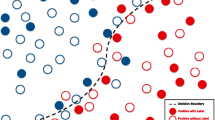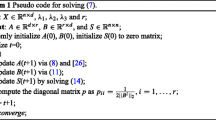Abstract
As an important part of multimedia analysis applications, feature selection has attracted much attention during the past decades. Lots of feature selection methods have been proposed, but most of them neglect to consider the correlation between the selected features, which leads to the feature redundancy problem. In this paper, we propose a novel supervised feature selection method, termed as Uncorrelated Discriminant Sparse Regression (UDSR). This method is an organic combination of discriminant sparse regression and uncorrelated constraint. In this method, the discriminant sparse regression ensures the discriminant power of the selected features, and the uncorrelated constraint avoids the redundancy of selected features. Thus the features selected by our method are not only discriminative but also uncorrelated with each other. The method can be applied to a wide range of multimedia applications. Experiments are conducted on two video datasets and four image datasets. The experimental results show that the proposed method has better performance for multimedia analysis, compared to the baseline and six state-of-the-art relative methods.





Similar content being viewed by others
Change history
05 September 2022
A Correction to this paper has been published: https://doi.org/10.1007/s11042-022-13682-6
References
Chao YW, Wang Z, He Y, Wang J, Deng J (2015) Hico: a benchmark for recognizing human-object interactions in images. In: 2015 IEEE international conference on computer vision (ICCV), pp 1017–1025. IEEE
Chen X, Yuan G, Nie F, Zhong M (2018) Semi-supervised feature selection via sparse rescaled linear square regression. IEEE Trans Knowl & Data Eng 32(1):165–176
Delaitre V, Laptev I, Sivic J (2010) Recognizing human actions in still images: a study of bag-of-features and part-based representations. In: BMVC, vol 2, p 7
Ding C, Peng H (2005) Minimum redundancy feature selection from microarray gene expression data. J Bioinform Comput Biol 3(02):185–205
Duda RO, Hart PE, Stork DG (2001) Pattern classification 2nd edn. Wiley, New York
Golub GH, Loan V (1996) Matrix computations. Math Gaz, vol 74(469)
Gu K, Liu H, Xia Z, Qiao J, Lin W, Thalmann D (2021) Pm2.5 monitoring: use information abundance measurement and wide and deep learning. IEEE Trans Neural Netw Learn Syst 32(10):4278–4290
Gu K, Xia Z, Qiao J (2019) Stacked selective ensemble for pm 2.5 forecast. IEEE Trans Instrum Meas 69(3):660–671
Gu K, Xia Z, Qiao J, Lin W (2019) Deep dual-channel neural network for image-based smoke detection. IEEE Trans Multimedia 22(2):311–323
Gu K, Zhai G, Lin W, Liu M (2015) The analysis of image contrast: from quality assessment to automatic enhancement. IEEE Trans Cybern 46(1):284–297
Gu K, Zhang Y, Qiao J (2020) Ensemble meta-learning for few-shot soot density recognition. IEEE Trans Industr Inform 17(3):2261–2270
Gupta A, Kembhavi A, Davis LS (2009) Observing human-object interactions: using spatial and functional compatibility for recognition. IEEE Trans Pattern Anal Mach Intell 31(10):1775–1789
Han D, Kim J (2015) Unsupervised simultaneous orthogonal basis clustering feature selection. In: 2015 IEEE conference on computer vision and pattern recognition (CVPR), pp 5016–5023. IEEE
Han Y, Yang Y, Zhou X (2013) Co-regularized ensemble for feature selection. In: Twenty-third international joint conference on artificial intelligence, pp 1380–1386
Han Y, Zhang J, Xu Z, Yu S-I (2013) Discriminative multi-task feature selection. In: Workshops at the twenty-seventh AAAI conference on artificial intelligence
He X, Cai D, Niyogi P (2006) Laplacian score for feature selection. In: Advances in neural information processing systems, pp 507–514
Henry ER, Hofrichter J (1992) [8] Singular value decomposition: application to analysis of experimental data. Meth Enzymol 210:129–192
Hou C, Nie F, Li X, Yi D, Wu Y (2013) Joint embedding learning and sparse regression: a framework for unsupervised feature selection. IEEE Trans Cybern 44(6):793–804
Huang Q, Tao D, Li X, Jin L, Wei G (2011) Exploiting local coherent patterns for unsupervised feature ranking. IEEE Trans Syst Man Cybern, Part B (Cybern) 41(6):1471–1482
Ikizler N, Cinbis RG , Pehlivan S, Duygulu P (2008) Recognizing actions from still images. In: 19th International conference on pattern recognition, 2008. ICPR, 2008, pp 1–4. IEEE
Jégou H, Douze M, Schmid C, Pérez P (2010) Aggregating local descriptors into a compact image representation. In: 2010 IEEE conference on computer vision and pattern recognition (CVPR), pp 3304–3311. IEEE
Kumar J, Peng Y, Doermann D (2014) Structural similarity for document image classification and retrieval. Pattern Recogn Lett 43(1):119–126
Kwak S, Cho M, Laptev I (2016) Thin-slicing for pose: learning to understand pose without explicit pose estimation. In: 2016 IEEE conference on computer vision and pattern recognition (CVPR), pp 4938–4947. IEEE
Li Y, Xia R, Huang Q, Xie W, Li X (2017) Survey of spatio-temporal interest point detection algorithms in video. IEEE Access 5:10323–10331
Li X, Zhang H, Zhang R, Liu Y, Nie F (2018) Generalized uncorrelated regression with adaptive graph for unsupervised feature selection. IEEE Trans Neural Netw Learn Syst 30(5):1587–1595
Li X, Zhang H, Zhang R, Nie F (2019) Discriminative and uncorrelated feature selection with constrained spectral analysis in unsupervised learning. IEEE Trans Image Process 29(1):2139–2149
Liao X, Li K, Zhu X, Liu KR (2020) Robust detection of image operator chain with two-stream convolutional neural network. IEEE IEEE J Sel Top Signal Process 14(5):955–968
Liao Xin, Yin Jiaojiao, Chen Mingliang, Qin Zheng (2020) Adaptive payload distribution in multiple images steganography based on image texture features. IEEE Trans Dependable Secure Comput
Liao X, Yu Y, Li B, Li Z, Qin Z (2019) A new payload partition strategy in color image steganography. IEEE Trans Circuits Syst Video Technol 30 (3):685–696
Liu H, Sun J, Liu L, Zhang H (2009) Feature selection with dynamic mutual information. Pattern Recogn 42(7):1330–1339
Liu J, Yang Y, Shah M (2009) Learning semantic visual vocabularies using diffusion distance. In: 2009 IEEE computer society conference on computer vision and pattern recognition (CVPR 2009), Miami, Florida, USA, pp 461–468. IEEE
Liu K, Yang X, Yu H, Mi J, Wang P, Chen X (2019) Rough set based semi-supervised feature selection via ensemble selector. Knowl-Based Syst 165:282–296
Lowe DG (2004) Distinctive image features from scale-invariant keypoints. Int J Comput Vis 60(2):91–110
Mohino-Herranz I, Gil-Pita R, garcía-gómez J, Rosa-Zurera M, Seoane F (2020) A wrapper feature selection algorithm: an emotional assessment using physiological recordings from wearable sensors. Sensors 20(1):309
Nie F, Huang H, Xiao C, Chris H, Ding Q (2010) Efficient and robust feature selection via joint l2, 1-norms minimization. In: Advances in neural information processing systems (NIPS), Vancouver, British Columbia, Canada, pp 1813–1821
Nie F, Xiang S, Jia Y, Zhang C, Yan S (2008) Trace ratio criterion for feature selection. In: AAAI, vol 2, pp 671–676
Nie F, Yang S, Zhang R, Li X (2018) A general framework for auto-weighted feature selection via global redundancy minimization. IEEE Trans Image Process 28(5):2428–2438
Pang Y, Zhou B, Feiping N (2019) Simultaneously learning neighborship and projection matrix for supervised dimensionality reduction. IEEE Trans Neural Netw Learn Syst 30(9):2779–2793
Peng H, Long F, Ding C (2005) Feature selection based on mutual information criteria of max-dependency, max-relevance, and min-redundancy. IEEE Trans Pattern Anal Mach Intell 27(8):1226–1238
Prest A, Schmid C, Ferrari V (2012) Weakly supervised learning of interactions between humans and objects. IEEE Trans Pattern Anal Mach Intell 34 (3):601–614
Ramjee S, Gamal AE (2019)
Sáez JA, Corchado E (2019) Ksufs: a novel unsupervised feature selection method based on statistical tests for standard and big data problems. IEEE Access 7:99754–99770
Sayed GI, Hassanien AE, Azar AT (2019) Feature selection via a novel chaotic crow search algorithm. Neural Comput Appl 31(1):171–188
Schuldt C, Laptev I, Caputo B (2004) Recognizing human actions: a local svm approach. In: Proceedings of the 17th international conference on pattern recognition, 2004. ICPR 2004, pp 32–36
Sharma A, Paliwal KK, Imoto S, Miyano S (2014) A feature selection method using improved regularized linear discriminant analysis. Mach Vis Appl 25(3):775–786
Shi C, Gu Z, Duan C, Tian Q (2020) Multi-view adaptive semi-supervised feature selection with the self-paced learning. Signal Process 168:107332
Shirzad MB, Keyvanpour MR (2015) A feature selection method based on minimum redundancy maximum relevance for learning to rank. In: AI & Robotics (IRANOPEN), pp 1–5. IEEE
Song F, Mei D, Li H (2010) Feature selection based on linear discriminant analysis. In: International conference on intelligent system design and engineering application, vol 1, pp 746–749. IEEE, 2010
Tang J, Hu X, Gao H, Liu H (2014) Discriminant analysis for unsupervised feature selection. In: proceedings of the SIAM international conference on data mining, pp 938–946, SIAM, 2014
Wang H, Kläser A, Schmid C, Liu C-L (2013) Dense trajectories and motion boundary descriptors for action recognition. Int J Comput Vis 103 (1):60–79
Wang D, Nie F, Huang H (2014) Unsupervised feature selection via unified trace ratio formulation and k-means clustering (track). In: Joint european conference on machine learning and knowledge discovery in databases. Springer, pp 306–321
Wang D, Nie F, Huang H (2015) Feature selection via global redundancy minimization. IEEE Trans Knowl Data Eng 27(10):2743–2755
Wang H, Ullah MM , Klaser A, Laptev I, Schmid C et al (2009) Evaluation of local spatio-temporal features for action recognition. In: BMVC 2009-British machine vision conference
Wang J, Wu L, Kong J, Li Y, Zhang B (2013) Maximum weight and minimum redundancy: a novel framework for feature subset selection. Pattern Recogn 46(6):1616–1627
Xiao C, Nie F, Huang H, Chris H, Ding Q (2011) Multi-class l2,1-norm support vector machine. In: 11th IEEE international conference on data mining, ICDM, 2011, Vancouver, BC Canada, 2011, pp 91–100. IEEE
Yang Y, Li H, Lin X, Ming D (2010) Recursive feature selection based on minimum redundancy maximum relevancy. In: 2010 3rd International symposium on parallel architectures, algorithms and programming, pp 281–285. IEEE
Yang Y, Shen HT, Ma Z, Huang Z, Zhou X (2011) L2, 1-norm regularized discriminative feature selection for unsupervised. In: Twenty-second international joint conference on artificial intelligence
Yang Z, Wang H, Han Y, Zhu X (2018) Discriminative multi-task multi-view feature selection and fusion for multimedia analysis. Multimed Tools Appl 77(3):3431–3453
Yao B, Fei-Fei L (2010) Grouplet: a structured image representation for recognizing human and object interactions. In: 2010 IEEE conference on computer vision and pattern recognition (CVPR), pp 9–16. IEEE
Zhang C, Hu Q, Fu H, Zhu P, Cao X (2017) Latent multi-view subspace clustering. In: 2017 IEEE conference on computer vision and pattern recognition (CVPR), pp 4279–4287. IEEE
Zheng W, Zhu X, Wen G, Zhu Y, Yu H , Gan J (2018) Unsupervised feature selection by self-paced learning regularization. Pattern Recognit Lett
Acknowledgements
This work was supported in part by the Chinese Natural Science Foundation (CNSF) (under Grant 61702165). This work was supported in part by the S&T Program of Hebei, China (under Grant F2020111001). This work was supported in part by the Scientific Research Project of Hengshui University (under Grant 2021GC17, Grant 2021yj18). This work was supported in part by the Humanities and Social Sciences project of the Ministry of Education(under Grant 18YJCZH129).
Author information
Authors and Affiliations
Corresponding author
Ethics declarations
The authors declare that they have no competing financial interests or personal relationships that could have appeared to influence the work reported in this paper.
Additional information
Publisher’s note
Springer Nature remains neutral with regard to jurisdictional claims in published maps and institutional affiliations.
The original version of this article was revised: The orignal publication of this article contains incorrect order of affiliations 1 and 2.
Rights and permissions
Springer Nature or its licensor holds exclusive rights to this article under a publishing agreement with the author(s) or other rightsholder(s); author self-archiving of the accepted manuscript version of this article is solely governed by the terms of such publishing agreement and applicable law.
About this article
Cite this article
Guo, S., Zhang, J., Zhang, W. et al. Feature selection via uncorrelated discriminant sparse regression for multimedia analysis. Multimed Tools Appl 82, 619–647 (2023). https://doi.org/10.1007/s11042-022-13258-4
Received:
Revised:
Accepted:
Published:
Issue Date:
DOI: https://doi.org/10.1007/s11042-022-13258-4




